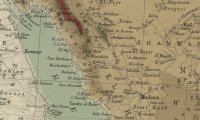Research Project al-ʿUlā AS: 2019-2024
– al-ʿUlā AS Project: Anthropological survey of al-ʿUlā community and its oasis system
– Principal investigator: Dr Vincent Battesti
Located in the northwest of the Kingdom of Saudi Arabia, the oasis of al-ʿUlā, previously considered a remote and isolated territory, is the recent focus of an ambitious development project by the government of the Saudi monarchy (led by the Royal Commission for AlUla).
Prior to any ambitious project, an in-depth study is essential to determine the true nature of the al-ʿUlā oasis. The challenge is to rely on other oasis cases without overlooking the local anthropological and ecological specificities and to highlight its social and economic functioning. As al-ʿUlā is mainly an agricultural terroir, oasis agriculture deserves special attention (Battesti, 2005), and in particular, the date palm (Phoenix dactylifera L.)—see the project “Ethnographic, genetic, and morphometric analyses of the date palm agrobiodiversity in al-ʿUlā oasis” (dir. by Drs. Vincent Battesti & Muriel Gros- Balthazard)—, the keystone species of this complex and ingenious human-made system. But even beyond the date palm: an oasis is a full socio-ecosystem and a valuable natural and cultural heritage. It combines a complex multilayered agriculture system, cultivated species, and local knowledge and practices. A primary focus should aim to understand how this system functions and how it has recently evolved. What is its agrobiodiversity, how can it even be measured? Experience (Battesti, 2013; Battesti & Gros-Balthazard et al., 2018) shows that such an assessment cannot be effectively carried out without considering the local categorization of life, including animals and plants, and without acknowledging that the local population and its traditional environmental knowledge (TEK) and know-how are the originators and maintainers of this agroecological diversity. This local human population, with its different identities and often complex social organizations, must also be included in the study.
From a scholarly standpoint, little is known about the current state of the oasis. We are unaware of any sociological or ethnological analysis of the oasis (but a book published in Saudi Arabia by Naseef, 1995). There is also no evaluation of the richness of the local agrobiodiversity of oasis plants and animal. We propose an understanding of al-ʿUlā oasis through a general and interdisciplinary diagnosis aimed at addressing relevant local anthropological issues. We propose an assessment of the local agrobiodiversity and its origins, using a multidisciplinary approach that combines anthropology, ethnoecology (including ethnobotany and ethnozoology), and agronomy. The objective is also to describe the functioning of the oasis as a whole, as a complex result of long-term and daily adjustments by humans and non-humans, by including in our research the urban environment and the habitat of the humans and their evolutions.
A doctoral student has been recruited on this al-ʿUlā AS research project for a four-year (2019-2024) thesis in social anthropology (CNRS): Léo Marty.
An agricultural engineer has been recruited on this al-ʿUlā AS research project (2023-2024) (CNRS): Élise Gaury.
al-ʿUlā AS research Project



























